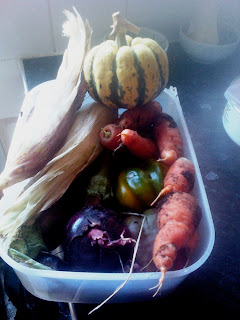Well it's that time of year again when the floors are littered with a multitude of colourful leaves. These are the days I like heading into the woods and observing their preparations for the cold months ahead. There's a lot we can learn from just sitting still and putting our five senses to work. Winter is on the way but funny enough the temperature here in south London is still quite mild for this time of year. This is a God send as we can still work outdoors without much discomfort.
We have been recognised as an official Permaculture site and are now one of the Permaculture Associations' LAND demonstration site. We can be very proud of what we have achieved in such a short period of time. For us at May Project Gardens it's all about replenishing the soil and sowing winter veggies. Last week we managed to transplant most of the winter salads (mainly winter lettuce, spinach, and chard), we also got some garlics in and we hope we will have as good a crop, or even better, as we did this past season. As the days grow short we harvest most of our herbs and hang them up to dry in our storage shed.
Herbs and seeds drying
The majority of the work being done in the garden is in preparation for spring. We've got most of our seeds dried and stored, all the beds have been covered with mulch and early crops have been planted and now awaits the warmish spring air.
Winter crops (salads, garlics, and chards)
As mentioned in previous posts, we have been making a great deal of compost and since we started making out own compost we have no need to buy from the shops which has allowed us to save quite a bit of money. A very close friend of mine is currently doing a very intensive course on Permaculture and Practical Sustainability in Ireland and has been giving us pointers on being more efficient in the use of compost. Apparently quick compost is mainly bacteria base and much better for trees and shrubs, and compost which takes slightly longer to mature is much better for veg plants. Something else we learnt was that this time of year is not ideal for tree pruning. Reason being that this is the time of year when fungus (mushroom) are at their most active, releasing trillions of spores into the air and these spores are actively seeking out dead or freshly wounded trees to feed on. So late winter/early spring would be the best time to prune fruit trees for example. I also find that using a bit of wax to help seal the pruned tree would help prevent fungal infections.
We have made a lot of compost this year and a lot of it was added to the front garden which is now looking very healthy.
Front garden
This year has not only been garden work. We held a musical fundraiser on the 11/11/11 at the Tooting Market in south London and it went down really well. Check out the video clip of the event Come We Grow video clip. We are very close to becoming self sufficient in terms of food and are now working on water storage and purification as well as housing and energy. At the moment we are half way with our pallet house build and I will post the process on this blog once it is completed.









































































